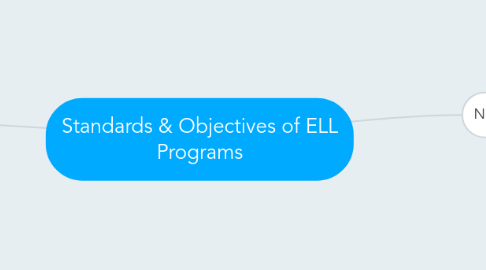
1. Florida Standards
1.1. Domain 1: Culture (Cross-Cultural Communications)
1.1.1. Standard 1: Culture as a Factor in ELLs’ Learning
1.2. Domain 2: Language and Literacy (Applied Linguistics)
1.2.1. Standard 1: Language as a System
1.2.2. Standard 2: Language Acquisition and Development
1.2.3. Standard 3: Second Language Literacy Development
1.3. Domain 3: Methods of Teaching English to Speakers of Other Languages (ESOL)
1.3.1. Standard 1: ESL/ESOL Research and History
1.3.2. Standard 2: Standards-Based ESL and Content Instruction
1.3.3. Standard 3: Effective Use of Resources and Technologies
1.4. Domain 4: ESOL Curriculum and Materials Development
1.4.1. Standard 1: Planning for Standards-Based Instruction of ELLs
1.4.2. Standard 2: Instructional Resources and Technology
1.5. Domain 5: Assessment (ESOL Testing and Evaluation)
1.5.1. Standard 1: Assessment Issues for ELLs
1.5.2. Standard 2: Language Proficiency Assessment
1.5.3. Standard 3: Classroom-Based Assessment for ELLs
1.6. St. Lucie School District
1.6.1. Instruction
1.6.2. Material Adaptation
1.6.3. Student Involvement
1.6.4. Assessment
1.6.5. Language Facilitation
1.6.6. Parental Involvement
2. New Jersey Standards
2.1. Hackettstown School District
2.1.1. Goals & Objectives
2.1.1.1. Goal #1 To use English to communicate in social settings
2.1.1.2. Goal #2: To use English to achieve academically in all content areas
2.1.1.3. Goal #3: To use English in socially and culturally appropriate ways
2.1.1.4. Goal #4: Teachers will encourage their school district to develop an ESL objectives-based curriculum and assessment system
2.1.1.5. Goal #5: To develop and maintain in each student a positive attitude toward his/her own native culture and an appreciation of cultural diversity
2.1.2. ESL Program
2.1.2.1. In-service training
2.1.2.2. Ss received 45-90 mins. daily instruction with ESL teacher and bilingual teaching assistant
2.1.2.3. Bilingual teaching assistant
2.1.2.4. Regular meetings
2.1.2.5. End of year
2.1.2.6. Teaching strategies
2.1.2.6.1. Teachers integrate listening, speaking, reading and writing activities into each theme-based unit.
2.1.2.6.2. Teachers organize literacy instruction based on a logical progression from structured teacher-guided activities toward increasing levels of independent reading and writing activities.
2.1.2.6.3. Teachers structure systematic lessons to include presentations of concepts and vocabulary and many opportunities for guided and independent practice
2.1.2.6.4. Teachers provide integrated, guided and shared reading and writing activities
2.1.2.6.5. Teachers analyze and select literacy texts for instruction and independent reading based on student’s skill levels and ability to handle the challenges of the text
2.1.2.6.6. Teachers design and implement balanced literacy and bilingual instruction to meet the learning needs and challenges of all bilingual students
2.1.2.6.7. Teachers use multicultural literature to enhance and refine student enjoyment and appreciation of their own and each other's cultures
2.1.2.6.8. Specific example
